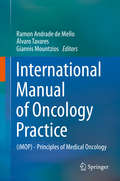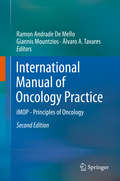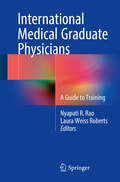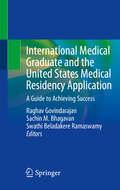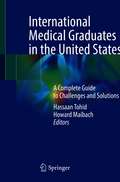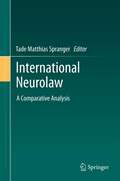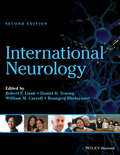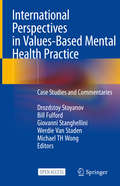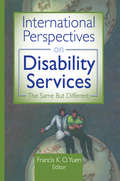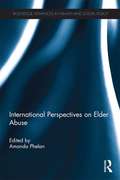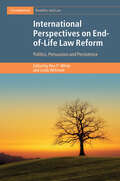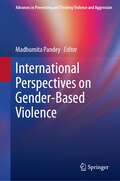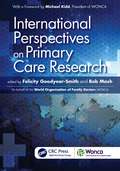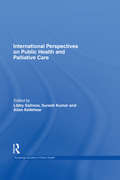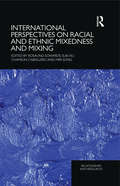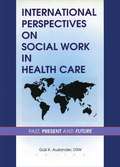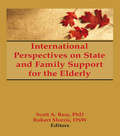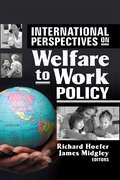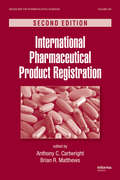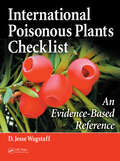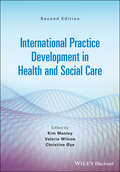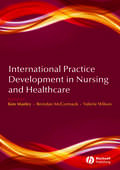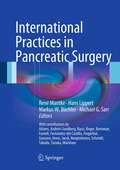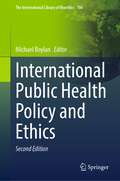- Table View
- List View
International Manual of Oncology Practice
by Ramon Andrade Mello Álvaro Tavares Giannis MountziosThis textbook addresses themes ranging from the molecular issues of cancer sciences to clinical practice in medical oncology. It clarifies many topics, including molecular oncology, chemotherapy pharmacology and practical issues for clinicians. Systemic treatments in many areas of oncology feature, such as breast cancer, gastrointestinal, thoracic, urological oncology, head and neck tumors, bone tumors, sarcomas and palliative care. An excellent source for young physicians and researchers in the field of oncology, this book furthers understanding of medical oncology practice and facilitates professionals' treatment of cancer patients. It sets the direction for future research in the field, and will become the readers' regular working tool.
International Manual of Oncology Practice: iMOP - Principles of Oncology
by Giannis Mountzios Ramon Andrade De Mello Álvaro A. TavaresCancer is a very aggressive disease and currently it has been considered a challenge to oncologists and cancer patients worldwide. Nowadays, several therapeutic strategies had improved toward last decades. Surgery is many times still the best curative treatment, mainly in early stage disease. However, Radiotherapy and chemotherapy acquired a main role in this scenario. Target therapies were introduced for medical oncology practice and are demonstrating a hallmark of a new era in cancer treatment. More recently, immunotherapy has been considered the novel cornerstone in cancer treatment. The 2nd edition of the International Manual of Oncology Practice (iMOP) emerged after the great success of the iMOP 1st edition as a reference for medical oncologists and medical residents in the field. In this edition, several chapters were revised and its addresses from the molecular issues of cancer sciences to the clinical practice in medical oncology. In addition, multiple choice questions and clinical cases were included in the main chapters in order to improve the reader learning. The book focuses systemic treatments in many areas of medical oncology, such as breast cancer, gastrointestinal, thoracic, urological oncology, head and neck tumors, bone tumors, sarcomas and palliative care. The topics herein discussed will provide the readers a step forward in the medical oncology practice understanding and give facilities for help in cancer patient treatments.
International Medical Graduate Physicians
by Laura Weiss Roberts Nyapati R. RaoMany thousands of international graduate physicians from diverse medical specialties serve the health care needs of the United States, and one-in-four psychiatry residents are international medical graduates. International Medical Graduate Physicians: A Guide to Training was created by prominent leaders in academic psychiatry to support the success of these international medical graduate physicians as they complete their clinical training and enter the physician workforce in this country. This insightful title has been developed as a valuable resource, filled with key information and personal narratives, to foster optimal wellbeing and decisionmaking of IMG physicians as they navigate their careers. The text is thorough in scope and replete with perspectives, reflections, and tailored guidance for the reader. Many of the chapters are based on the direct and diverse life experiences of the authors. A unique and thoughtful contribution to the literature, this Guide will be of great value to international physicians and to their teachers and supervisors in psychiatry as well as other specialties of medicine.
International Medical Graduate and the United States Medical Residency Application: A Guide to Achieving Success
by Raghav Govindarajan Sachin M. Bhagavan Swathi Beladakere RamaswamyThis unique, socially conscience reference provides valuable guidance to international medical graduates (IMG’s) looking to complete a residency in the United States. The medical residency application process in the United States is competitive and complex. Additionally, many IMG’s go through training programs that sharply differ from the medical school training and the sociocultural elements of United States medicine and residency are unlike any other country. Organized into three parts, this book meets the need for a pragmatic, evidence based guide that answers important questions, and imparts indispensable advice to IMGs. Part I directly tackles the concerns IMG’s have regarding specific elements of residency applications, including the importance of a master’s degree and how to get a strong letter of recommendation. Part II then addresses how to prepare for interviews, preliminary programs and travel. Finally, the book answers the common “what ifs” and “what’s next” questions many IMG’s ponder. International Medical Graduate and the United States Medical Residency Application: A Guide to Achieving Success is a first-of-its-kind resource that presents a holistic view of residency application peppered with real life examples, easy to grasp tables and flow charts and key do’s and don’ts to drive home the complex process involved in residency application.
International Medical Graduates in the United States: A Complete Guide to Challenges and Solutions
by Howard Maibach Hassaan TohidThousands of international medical graduates come to the United States to start their career as physicians. Many of them, however, are not aware of the challenges and problems that they may encounter along the way. These difficulties can range from the language and cultural barriers to a lack of confidence and self-esteem. Many students are also unaware of the other career options besides getting into a clinical residency program. As a result of these issues, a great number of foreign medical students remain unmatched into the National Resident Matching Program. Not matching can be devastating for these graduates, both financially and medically. Students often suffer from psychological effects like major depression and generalized anxiety disorder. This book outlines the potential problems faced by these graduates and their possible solutions. Each chapter collects research evidence, interviews and surveys to gather information to work on each possible problem one by one and describes a solution in great detail. Comprised of thirty chapters, each chapter is broken down into smaller sub-sections to investigate the main theme in depth. Issues addressed include the different types of international medical graduates and their lives in the United States, differences in the education system and healthcare system, the triangle of residency, language and cultural barriers, lack of professional contacts, confidence, self-image and self-esteem issues, and restriction to specific fields and career paths. Written by experts in the field, International Medical Graduates in the United States is a first of its kind text that addresses the biggest issues faced by foreign medical graduates in today's world.
International Neurolaw
by Tade Matthias SprangerWhereas the past few years have repeatedly been referred to as the "era of biotechnology", most recently the impression has emerged that at least the same degree of attention is being paid to the latest developments in the field of neurosciences. It has now become nearly impossible to maintain an overview of the number of research projects dealing with the functionality of the brain - for example concerning its organizational structure - or projects dealing with the topics of legal responsibility, brain-computer interface applications, neuromarketing, lie detection or mind reading. These procedures are connected to a number of legal questions concerning the framework conditions of research projects as well as the right approach to the findings generated. Given the primary importance of the topic for the latest developments, it is essential to compare the different legal systems and strategies that they offer for dealing with these legal implications. Therefore, the book International Neurolaw - A Comparative Analysis contains several country reports from around the world, as well as those of international organizations such as UNESCO, in order to show the different legal approaches to the topic and possible interactions.
International Neurology
by Roongroj Bhidayasiri William M. Carroll Robert P. Lisak Daniel D. TruongThis unique textbook deals with the variations in the causes, presentations and treatment of neurological disease throughout human populations. International Neurology is an indispensable guide to the full range of neurological conditions you will see in your ever-changing patient population. Comprehensive coverage of neurological diseases and disorders with a clinical approach to diagnosis, treatment and management Truly international authorship distils expert knowledge from around the world Succinct, bite-sized, templated chapters allow for rapid clinical referral Further reading recommendations for each chapter guide readers requiring more depth of information Endorsed by the World Federation of Neurology
International Perspectives in Values-Based Mental Health Practice: Case Studies and Commentaries
by Giovanni Stanghellini Bill Fulford Drozdstoy Stoyanov Werdie Van Staden Michael Th WongThis open access book offers essential information on values-based practice (VBP): the clinical skills involved, teamwork and person-centered care, links between values and evidence, and the importance of partnerships in shared decision-making. Different cultures have different values; for example, partnership in decision-making looks very different, from the highly individualized perspective of European and North American cultures to the collective and family-oriented perspectives common in South East Asia. In turn, African cultures offer yet another perspective, one that falls between these two extremes (called batho pele).The book will benefit everyone concerned with the practical challenges of delivering mental health services. Accordingly, all contributions are developed on the basis of case vignettes, and cover a range of situations in which values underlie tensions or uncertainties regarding how to proceed in clinical practice. Examples include the patient’s autonomy and best interest, the physician’s commitment to establishing high standards of clinical governance, clinical versus community best interest, institutional versus clinical interests, patients insisting on medically unsound but legal treatments etc. Thus far, VBP publications have mainly dealt with clinical scenarios involving individual values (of clinicians and patients). Our objective with this book is to develop a model of VBP that is culturally much broader in scope. As such, it offers a vital resource for mental health stakeholders in an increasingly inter-connected world. It also offers opportunities for cross-learning in values-based practice between cultures with very different clinical care traditions.
International Perspectives on Disability Services: The Same But Different
by Francis K.O. YuenLearn how to include multiculturalism in disability-related social work! International Perspectives on Disability Services: The Same but Different presents different cultural and societal contexts on services for people with disabilities. This book covers a range of topics on disabilities related to physical status, emotional conditions, and community settings. This useful introductory reference will help you develop culturally sensitive disability services both locally and overseas, and it will promote better understanding of people with disabilities. This book is a unique examination of services for people with disabilities as they exist in several countries. Until recently, cultural context was used to describe race or ethnicity, but this innovative text recognizes people with disabilities as a worldwide community that is advocating for equality and respect. International Perspectives on Disability Services focuses on the need for human and social services that endorse capability and empowerment-promoting the person rather than the disability. In International Perspectives on Disability Services, you&’ll learn about: using the term "culture" to describe the community of people with disabilities-how cultural sensitivity and competency can be applied to the disability culture the dynamics of a transcultural relationship between psychotherapist and deaf or hard-of-hearing individuals the recent development in aphasia treatment-Life Participation Approach to Aphasia (LPAA)-and the international perspective of communication therapy a comparison of attitudes among social work students in the United States and Japan toward people with disabilities-people with disabilities are not yet integrated into Japanese society, but both groups showed room for needed improvement a comparison of disability-related services and experiences in the United States and in Germany-child-raising leave, child-raising money, and Kindergeld (child money) helps support parents financially for the first few years, but the United States has more options for integrated schooling later in life Hong Kong&’s 25-year-old objective to encourage community integration and normalization for people with disabilities to live in the community the primary support network of family, community leaders, and shaman for people with disabilities among Hmong Americans in Northern California The informative reports, research findings, case studies, and international comparisons offer new directions for human service professionals and students to help them better meet the social, psychological, and cultural needs of people with disabilities. International Perspectives on Disability Services provides clear-cut evidence that disability-oriented social workers need to improve their perspectives as the disability culture gains momentum as a social entity. This book is a must-read for anyone who works or provides disability-related services, as well as for people with disabilities who need more information on other countries&’ services.
International Perspectives on Elder Abuse: Practice, Legislation And Policy (International Perspectives On Aging Ser. #24)
by Amanda PhelanElder abuse has been increasingly recognised over the past ten years in many countries and progress has been made in both understanding and addressing the issue. This volume provides a much-needed international overview of the topic. Opening with an examination of what elder abuse is, Amanda Phelan sets it in a theoretical context and looks at assessment and approaches to the issue in residential and community care environments. The book then presents a range of country studies, which provide an overview of the context of elder abuse in the country and a discussion of related policy, legislation, research and practice. Countries covered include Ireland, United Kingdom, Spain, China, Australia, Kenya, Israel, Canada and the United States, whilst a regional chapter looks at South America. A concluding chapter draws together cross-cultural comparisons and provides some guidance as to best practice. The only comprehensive book in this area, International Perspectives on Elder Abuse is an invaluable reference for practitioners, academics and researchers from a range of disciplines, including nursing, social work, sociology, public health and social policy.
International Perspectives on End-of-Life Law Reform: Politics, Persuasion and Persistence (Cambridge Bioethics and Law)
by Ben P. White Lindy WillmottMuch has been written about whether end-of-life law should change and what that law should be. However, the barriers and facilitators of such changes – law reform perspectives – have been virtually ignored. Why do so many attempts to change the law fail but others are successful? International Perspectives on End-of-Life Law Reform aims to address this question by drawing on ten case studies of end-of-life law reform from the United Kingdom, the United States, Canada, the Netherlands, Belgium and Australia. Written by leading end-of-life scholars, the book's chapters blend perspectives from law, medicine, bioethics and sociology to examine sustained reform efforts to permit assisted dying and change the law about withholding and withdrawing life-sustaining treatment. Findings from this book shed light not only on changing end-of-life law, but provide insight more generally into how and why law reform succeeds in complex and controversial social policy areas.
International Perspectives on Gender-Based Violence (Advances in Preventing and Treating Violence and Aggression)
by Madhumita PandeyThis book examines the multifaceted nature of gender-based violence (GBV) and the many forms it can take. It explores the area of GBV and its implications on human rights, law, and policy. The book highlights the significance of current international debates around preventing GBV and provides context for understanding GBV as a complex structural phenomenon deeply rooted in gender inequality. It addresses GBV as one of the most notable human rights violations within all societies and provides multiple global perspectives on GBV to address the common challenges and barriers to combating this issue.Key areas of coverage include:Sexual violence.Domestic violence.Intimate partner violence.Media Misogyny.Online trolling.Discrimination.Sex trafficking and modern slavery.Preventative Measures and role of men.International Perspectives on Gender-Based Violence is an essential resource for researchers, clinicians/therapists, and upper-level undergraduate and graduate students in developmental psychology, family policy, forensic psychology, human rights, public health, criminology/criminal justice, and clinical social work as well as all interrelated disciplines.
International Perspectives on Intimate Partner Violence: Challenges and Opportunities (AFTA SpringerBriefs in Family Therapy)
by Sandra M. Stith Chelsea M. SpencerThis book examines international perspectives on intimate partner violence (IPV). It highlights the current state of IPV prevention and intervention efforts across countries, including Colombia, Iran, Russia, China, India, Turkey, Nigeria, the United Kingdom, Finland, and the United States. The book examines the countries of origin in context (e.g., population, area, religion, ethnic diversity) and includes current rates of IPV in each country. In addition, it addresses growth areas and challenges regarding IPV prevention and intervention, including legal issues as well as cultural and social contexts and their relation to IPV – and the clinical interventions used – within each country. The book discusses challenges and opportunities for growth and seeks to gain a more robust and systemic perspective on the global phenomenon of IPV. It examines how larger social, cultural, and global factors affect the lives of the individuals whom family therapists serve and advocate for as well as provide guidance for culturally appropriate clinical and prevention practices. Key areas of coverage include: · International perspectives on intimate partner violence. · Intervention and resources available for victims of intimate partner violence. · Policies and laws relating to intimate partner violence. International Perspectives on Intimate Partner Violence is an essential resource for clinicians, therapists, and practitioners as well as researchers, professors, and graduate students in family studies, clinical psychology, and public health, as well as all interrelated disciplines.
International Perspectives on Primary Care Research (WONCA Family Medicine)
by Felicity Goodyear-Smith Bob MashInternational Perspectives on Primary Care Research examines how the evidence base from primary care research can strengthen health care services and delivery, tackle the growing burden of disease, improve quality and safety, and increase a person-centred focus to health care. <P><P>Demonstrating the inter-professional nature of the discipline, the book also features a section on cross-nation organisations and primary care networks supporting research. National perspectives are offered from researchers in 20 countries that form part of the World Organization of Family Doctors, providing case histories from research-rich to resource-poor nations that illustrate the range of research development and capacity building. <P><P>This book argues the importance of primary care research, especially to policy makers, decision makers and funders in informing best practice, training primary health care providers and achieving equitable distribution of care.
International Perspectives on Public Health and Palliative Care
by Allan Kellehear Suresh Kumar Libby SallnowPublic health approaches to palliative care have been growing in policy importance and practice acceptance. This innovative volume explores the major concepts, practice examples, and practice guidelines for this new approach. The goal of ‘comprehensive care’ – seamless support for patients as they transition between home based care and inpatient services – relies on the principles of health promotion and community development both to ensure services are available and importantly appropriate for patients’ needs. In developing contexts, where hospitals and hospices may be inaccessible, a public health approach provides not only continuity of care but greater access to good end of life care. This book provides both a historical and conceptual overview whilst offering practical case examples from affluent and developing contexts, in a range of clinical settings. Finally, it draws together research-based guidelines for future practice. Essential reading for public health researchers and practitioners with an interest in end of life care and global health as well as those involved in developing palliative care provision, International Perspectives on Public Health and Palliative Care is the first volume to present an overview of theory and practice in this emerging field.
International Perspectives on Racial and Ethnic Mixedness and Mixing (Relationships and Resources)
by Rosalind Edwards Miri Song Suki Ali Chamion CaballeroPeople from a ‘mixed’ or ‘inter’ racial and ethnic background, and people partnering and parenting across different racial and ethnic backgrounds, are of increasing political, public and intellectual interest internationally. Contributors to this interdisciplinary collection interrogate notions of mixedness and mixing, and challenge stereotypical assumptions. They advance debates in the field through illuminating the complexity of specific historical trajectories, administrative practices and lived experience. Recurrent themes woven throughout the chapters include: boundaries and categorisation in terms of administration and government, and also of lived experience the explicit and implicit politics of mixedness and mixing in terms of nation state interests, agenda and policies, as well as ‘on the ground’ social relations the ways that mixedness and mixing shift in meaning and implications across time and place, shaped by different national, regional and or local contexts. This volume shows that who is and is not ‘mixed’ is contested and understandings of mixedness and mixing, however conceived, need to be situated in the larger complex of ideas about race and its classification. International Perspectives on Racial and Ethnic Mixedness and Mixing is an invaluable book for students and scholars of race and ethnicity.
International Perspectives on Social Work in Health Care: Past, Present, and Future
by Gail K AuslanderIn the new health care environment, social workers are being called upon to act as case managers, coordinators, evaluators, therapists, and researchers. International Perspectives on Social Work in Health Care brings together academics and practitioners to discuss what managed care, cost containment, corporatization, and pre-payment portend for social work’s survival. Its explanatory pages will help you understand the need for skills in networking, mediation, and advocacy, how to link communities and institutions, and how to conceptualize, quantify, and measure the outcomes of social work interventions.In an effort to transcend traditional organizational and intellectual boundaries, International Perspectives on Social Work in Health Care explores conflicts inherent to social work, the need for new theoretical and practice models, social work administration in changing health care organizations, and developments in health social work research. Seeking to unite policy and practice, this guidebook addresses key issues, trends, and innovations in social work, including: services that enhance community health the transformation of health care in the U.S. into a market commodity a broader approach to health and health care to correct gender biases lifestyle changes and health promotion helping clients overcome patterns of denial, fear, and anger individual casework vs. group/community practice patterns of social work service provision in a rehabilitation hospital environment the effects of heterosexism on health and mental health services to lesbian and gay clientsInternational Perspectives on Social Work in Health Care acts as a forum for contributing authors and readers to exchange and gain information and learn from each others’experiences and expertise. This is the book to help social work academics, educators, and practitioners work together to meet the demands and challenges of the increasingly complex health care environment.
International Perspectives on State and Family Support for the Elderly
by Robert Morris *Deceased* Scott Bass Jill NortonWithin the context of long-range planning, this book examines the changing responsibilities of the state and family toward elders in different societies around the world. International Perspectives on State and Family Support for the Elderly presents a fresh range of lucid analyses of family caregiving policy from Canada, the United States, Sweden, the United Kingdom, Hong Kong, Austria, Denmark, Israel, and the People’s Republic of China. Different institutional structures, levels of economic development, and cultural values, among other factors, impact policy development in various countries. With the information examined in this book, readers can gain an understanding of elder care in other societies, which can help them in developing policies for their own countries.Authors of International Perspectives on State and Family Support for the Elderly address questions such as: Who is responsible for caring for the aged? What are the policy issues that determine how such care is handled in various countries? Are the underlying principles upon which policy is based changing? Who pays for the care of the aged? What is the balance of the roles of government, family, and community? Along with these questions, authors discuss: the importance of family care the well-being, payment, and rights of informal caregivers providing services for informal caregivers shifting the burden of care from formal organizations to families the effects of governmental frameworks on caregiving the impact of the political agenda on caregiving caregiving and the welfare stateInternational Perspectives on State and Family Support for the Elderly contains information for all professionals interested or involved in developing policy for the elderly. Demographers, sociologists, social workers, health care and public health professionals, gerontologists, and advanced students in these fields will find this book a helpful guide in their studies.
International Perspectives on Welfare to Work Policy
by James Midgley Richard HoeferLearn what you can do to promote social policy initiatives that really workInternational Perspectives on Welfare to Work Policy presents the latest available research on the various interpretations of "welfare-to-work" in the United States, the United Kingdom, Australia, and Hong Kong, and on the role social work plays in cr
International Pharmaceutical Product Registration
by Anthony C. Cartwright Brian R. MatthewsDiscover the latest ICH news from international experts in the pharmaceutical industry, academia, and regulatory bodies.The recent International Conference on Harmonisation (ICH) revisions of regulatory requirements for quality, nonclinical, and clinical pharmaceutical product registration are the focus of this timely update.This cutting-edge resou
International Poisonous Plants Checklist: An Evidence-Based Reference
by D. Jesse WagstaffKnowledge of plant toxicity has always been important, but the information has not always been reliable. Now, increasing international trade is drawing attention to the inadequacy of regional information and highlighting the geographical fragmentation and notorious discrepancies of thinly documented information. The international community of safet
International Practice Development in Health and Social Care
by Kim Manley Valerie Wilson Christine 216 YeThe second edition of International Practice Development in Health and Social Care remains the definitive resource for all those responsible for facilitating innovation and change in health and social care practice at every level. Fully revised and updated throughout, this new edition preserves its focus on developing person-centred, safe and effective evidence-based care that reflects the most recent health service modernisation agendas, clinical governance strategies, and quality improvement initiatives worldwide. In recent years, practice development (PD) supported by the International Practice Development Collaborative and the International Practice Development Journal has become increasingly interdisciplinary and globally focused. Accordingly, the second edition places greater emphasis on integrated health and social care, as well as on person-centred and community-focused approaches. New and updated chapters explore future challenges for practice development, readiness for transforming maternity services, new strategies for facilitating knowledge translation, education models for using the workplace as the main resource for learning, developing, and improving, and more. Designed to empower multi-professional healthcare teams to transform both the culture and context of care, this invaluable guide: Offers an accessible, interactive approach to a variety of complementary improvement approaches that integrate learning, development, improvement, knowledge translation and inquiry Delivers practical PD strategies guided by values of compassion, safety, efficacy, and person-centredness Provides recommendations for prioritising wellbeing in the workplace, enabling team effectiveness, and fostering collaboration and inclusion across health and social care systems Includes numerous real-world examples that connect theory with practice and illustrate field-tested PD methods Features contributions from Australia, Scandinavia, the UK, Germany, New Zealand, Switzerland, and the Netherlands, underscoring the text’s international focus International Practice Development in Health and Social Care is essential reading for multi-professional
International Practice Development in Nursing and Healthcare
by Brendan Mccormack Kim Manley Valerie WilsonInternational Practice Development in Nursing builds on Practice Development in Nursing, edited by the same editors and is the first book to develop a truly international practice development perspective.Practice development is a key concept in developing effective nursing care which is firmly embedded in health service modernisation agendas, clinical governance strategies, team and cultural developments and in quality improvements that directly impact on patient care in the UK and internationally. Practice development acknowledges the interplay between the development of knowledge and skills, enablement strategies, facilitation and a systematic, rigorous and continuous processes of emancipatory change in order to achieve evidence-based, person-centred care.International Practice Development in Nursing is an essential resource for all practice developers and for nurses with a remit for facilitating innovation and change in practice.
International Practices in Pancreatic Surgery
by Markus W. Büchler Michael G. Sarr Hans Lippert René Mantke"International Practices in Pancreatic Surgery" describes in great detail general and specific technical aspects of the standard resection procedures of the pancreas. Each surgical step during the pancreatic operation is precisely outlined and accompanied by drawings and photographs. The main chapters on pancreatic carcinoma, chronic and acute pancreatitis are written by the editors. An international faculty complements the texts by describing their own personal techniques. This concept offers the greatest possible overview of the techniques used by experienced surgeons.
International Public Health Policy and Ethics (The International Library of Bioethics #106)
by Michael BoylanThis second edition of International Public Health Policy and Ethics complements the popular first edition with contemporary problems in international public health. It brings together philosophers and practitioners to address the foundations and principles upon which public health policy may be advanced – especially in the international arena. What is the basis that justifies public health in the first place? Why should individuals be disadvantaged for the sake of the group? How do policy concerns and clinical practice work together and work against each other? Can the boundaries of public health be extended to include social ills that are amenable to group-dynamic solutions? What about political issues? How can international finance make an impact? These are some of the crucial questions that form the core of this volume of original essays sure to cause practitioners to engage in a critical re-evaluation of the role of ethics in public health policy. With a targeted new essay dealing with COVID and public health issues in Africa this second edition provides a resource building on the first edition.
